Arts and Crafts
Arts of Sri Lanka have achieved great heights during the path of history. All Sri Lankan art forms like dance, music, sculpture, paintings and architecture have grown over the time. with the influence of Buddhism, and other religious beliefs of the people. This laid a firm foundation to the base of Sri Lankan arts.
Dances of Sri Lanka
People of ancient Sri Lanka regarded dance as the best way to please the nature gods and danced to save themselves from natural disasters. Dancing started in Sri Lanka long before the 4th century BCE. However South Indian influence became obvious in Sri Lanka in the 15th century and it is particularly evident in the folk dances and local traditions. These influences made dances of an area different from the other.
Kandyan Dance
Kandyan Dance is regarded as the national dance form of Sri Lanka. The dance evolved primarily during the period of Kandyan kings; hence it was named Kandyan dancing. These dance form depicts scenes of Ramayana, tales of kings, queens, princes and heroes as well as dancing of kings and heroes. Costumes of the Kandyan dancers are quite elegant. Male dancers wear spectacular headgear and their bare chests are adorned with elegant silver regalia and also wear silver bangles on arms and anklets. They dance to the rhythms of drums which are called 'Bera'.

Sabragamuwa Dance
Sabaragamuwa Dance is performed in Ratnapura area to worship the God Saman. The Sabaragamuwa dance by its geographical location has taken from both the Low- Country and Kandyan. The Pang Madu (ritual of light) had at the beginning more of the Yak in it than the Kandyan. The more popular drum was the Yak Bera. Today the use of Daula drum gives the Sabaragamuwa a quaint peculiarity of its own and even the dresses of the dancers and drummers are austerely unique, though you see the elaborate Kandyan and Low-Country influence in them. In Sabaragamuwa dance the men take part in and allow their beloveds "Sindu Mathraya, Gaman Mathraya, Yakpada Mathraya, Patu Thala Mathraya etc. The drum is called "Daula" or "Tammettama" accompanied by the dance.
Low Country Dance
Low country dance is performed to please the sickness caused by evil spirits. The dancers wear masks. These masks resemble birds, demons, reptiles etc. This type of dance is highly ritualistic.
Handicrafts of Sri Lanka
Sri Lanka takes pride in its extensive variety of handicrafts. Tradition of making handicrafts is primeval. Requirements of the society and their creativeness combined to make these articles and serve as wonderful souvenirs. It can be found in shops and stores in all parts of the country.
Masks
Sri Lankans exclusively use masks and facial decorative wear. Since ancient times, masks have been used in rituals, dramas, and to cure sickness. Traditional Lankans think that masks have curative power for various physical and physiological illnesses. Most masks are made of light wood called Kaduru.
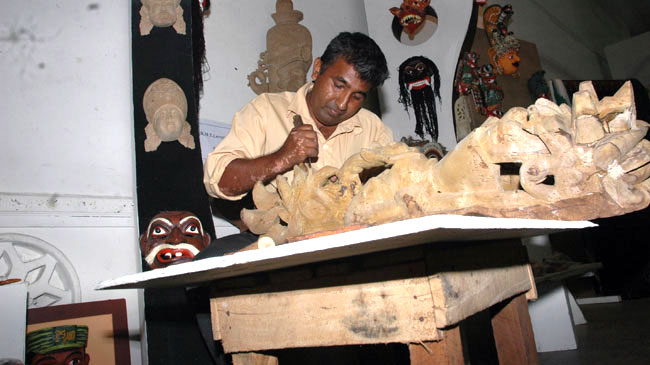
Pottery
Pottery is one of the oldest crafts in Sri Lanka and is still used by its populace as a daily utensil. Intricate products as terracotta figures, carved vases, etc are bought by the visitors as souvenirs.
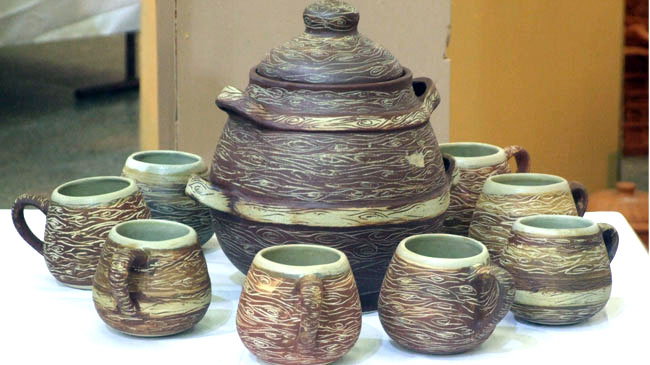
Batiks
Batik is basically an Indonesian art, but has evolved in Sri Lanka into its unique style. Tourists can find varieties of batiks sold throughout the island. More popular among these are the batik pictures made in Kandy and Fresco Batiks on the Peradeniya road in the outskirts of Kandy.
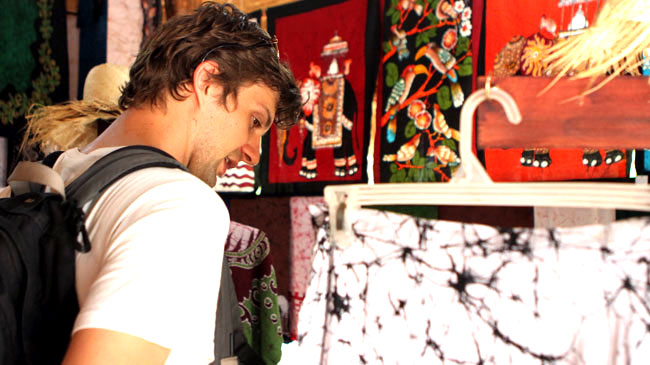
Metal Works
Sri Lanka has a long tradition in metalwork. Metalwork is produced with the whole range of metals and alloys in Sri Lanka: gold, silver, brass, tin, lead and iron, as well as their various alloys, in all sorts of work ranging from ornamental casting and pierced designs. Handicrafts of damascene - decorating metal such as iron or steel with wavy patterns of etching or inlays of precious metals and filigree-delicate decorative openwork made from thin precious metal twisted wire are produced in Sri Lanka in traditional techniques.

Metal Cutwork
Handicraft of metal cutwork involves cutting the design onto a flat sheet of metal first and embellishing the work by engraving, hatching or Repose secondly. This method is adopted mainly in production of metalwork such as trays and plaques. In Repose method, the desired pattern is hammered in on the reverse side so that the relief carvings emerge on the front side. Repose metalwork is the most characteristic type of Sri Lankan metalwork. This method is applied on brass, copper, silver, or all three together to create a variety of traditional designs.
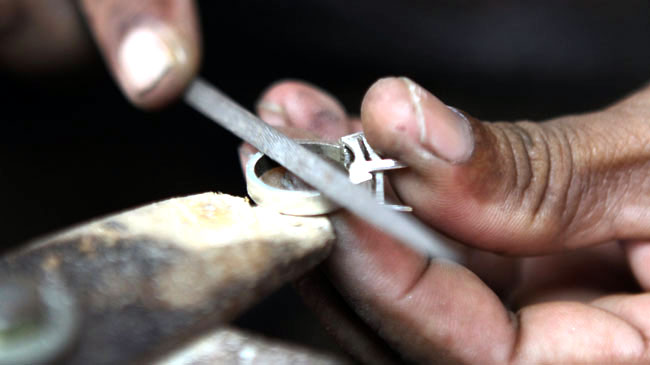
Brassware & Castings
Brassware is produced in two main techniques: wrought and cast. Bowls, tea services, trays, and ornamental ware as well as decorative ware are produced in wrought technique. Coconut oil lamps, pots, bowls, vases, wall plaques, trinket boxes and other household utensils are made with cast technique. Brass Castings are done by the "lost wax" method: the model is sculpted in wax, covered with clay, and baked so that the wax is melted out leaving the mould made of clay. Then the clay mould is poured with the molten Brass. The casting technique produces fine Brassware of elephants, Buddha images, bowls, lamps and candlesticks.
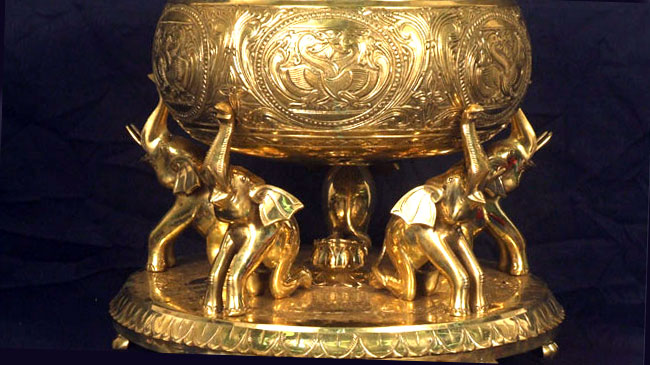
To make these products even more attractive, local craftsmen engrave the brassware with natural style motifs such as flowers, leaves, fruits and even sceneries. Silverware, like Brassware is a specialty of the Kandyan provinces, ornately carved and filigree jewellery, trays, trinket boxes, tea-sets, candle-stands, cutlery and ash-trays.
Jewellery
Sri Lanka is an outstanding maker of jewellery and its economy is benefitted to a great extent. There are two conventions of jewellery making; Galle and Kandyan traditions. Galle is known for its precious stones while the Kandyan tradition is carried by its intricate metalwork.
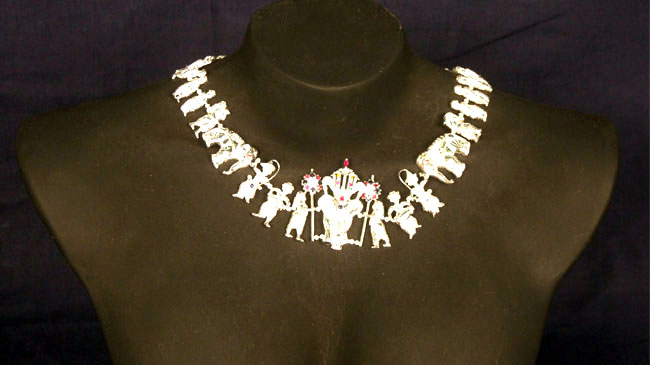
Wood Carving
Handicraft of woodcarving in Sri Lanka has a long history. The tradition of woodcarving in Sri Lanka is visible at Lankatilaka Temple and Ambekka Devale in Kandy. At these temples, miniature replicas of the low-relief wood carving done by the traditional woodcarvers can be bought at fair prices. The three dimensional carvings of ebony Elephants, Buddha are popular in Sri Lanka. Wood-carved decorative panels are used widely in Sri Lanka in the trade of interior decoration too. A wide range of handicraft items made of wood combine utility and beauty adding elegance to your lifestyle, such as wall hangings, fancy jewellery, figurines, sculpture, lacquer products, gift boxes, toys, educational items for pre-school children, household items are some of the woodcraft items produced in Sri Lanka.
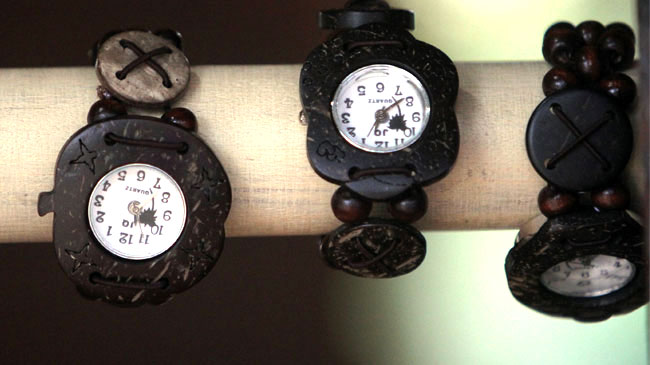
Lacquer Works
Lacquerwork in Sri Lanka is handicraft from the Kandyan provinces. Lac is a resin secreted from the bark of certain trees that have been infested with the Lac beetle. The resin is scraped from the bark, melted and strained. While the Lac is soft, pigment is beaten in to produce the desired colour and left to dry. Lac is applied in two different techniques. The method called spool-work is practiced with applying a stick of Lac to the object fixed onto a spindle of a lathe machine. The resulting friction caused by the revolving objects melts the Lac making it seep into the grain making a glossy coating on the object. Ornaments, walking sticks, book-ends, ash trays letteropeners, wooden handles etc are decorated with Lacquerwork. The method called nail work is practiced by using a thumbnail to fashion the thread of Lac. In addition to these traditional methods, today, Lacquer work is produced by an inferior method: painting the object and then covering it with layers of varnish.

Sri Lankan Handloom Textiles
Handloom textiles are produced in Sri Lanka within the confines of a small-scale industry that generates employment to rural women. Among the handloom textiles produced are household linen such as bedclothes and towels, upholstery materials, furnishing materials such as curtaining, cushion covers, saris and sarongs. Books, notebooks, albums, and even writing pads are now clothed with this handcrafted material of textile. The handloom woven in cotton and silk textiles of vibrant colours have been popular among locals and tourists.
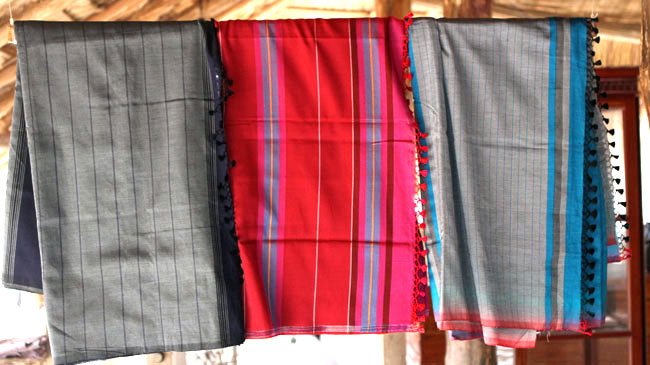
The combination of traditional designs with the latest trends in modern material woven using new processing techniques has made export quality handlooms so that Sri Lanka can access the competitive international market.
Sri Lanka exports curtaining, table linen, bed linen, kitchen linen, upholstery and dress fabric and other products to foreign markets. The products in demand in the local market are curtaining, table linen, bed linen furnishing, cushion covers, sarongs and saris. Currently, cotton and silk yarn is imported from India and Korea, monthly. Around 900 private handloom producers in small, medium and large-scale are operating in the country.
The handloom textile industry is a highly labour-intensive, export oriented rural-based industry. However, the lack of weavers and the high production cost have hampered the growth of the industry considerably. There is a slight decrease in the current workforce in the industry as it is labour-intensive. There were around 15,000 people working in the industry five years back.
Reed & Rush Ware
Reed and rush-wares are made of materials processed of Talipot or Thalakola, coconut and bamboo. Among the handcrafted products are table mats, cane furniture, mats, bags, purses, baskets, hats, boxes, lamp shades, kitchen and household articles and screens.
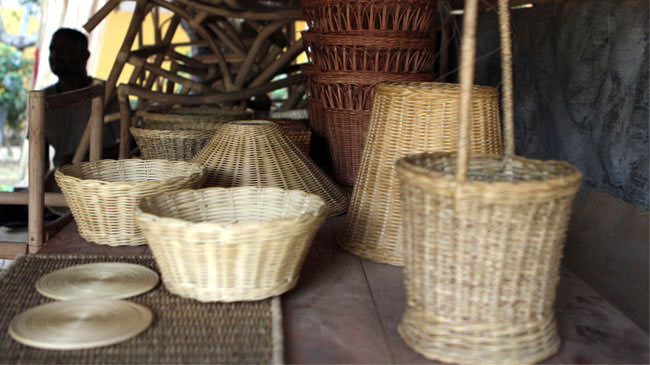
Mat Weaving in Sri Lanka
Since the ancient times, Mat weaving used to be practiced by rural women at home while their spouses were away at work in paddy fields or Chena cultivation in Sri Lanka. Today, mat weaving is a popular cottage industry with established sales outlets around the island. A fibre similar to Jute extracted from the leaves of Hana - hemp grown wild in the marshy lands of Sri Lanka is processed, dyed and woven in patterns. The modern Mat weaving craftsmen in Sri Lanka, to keep up with contemporary requirements, have introduced innovations in producing cushion covers, hand bags, shopping bags, letter holders, fans, screens etc. For centuries, Dumbara Valley of the Kandy District has been famous for its production of mats with distinctive design and colour schemes.
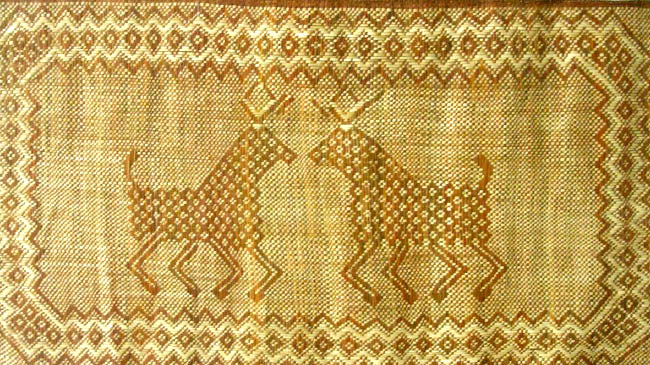
Lace Making
Lace making is not an indigenous art that was pioneered by the Portuguese in the 16th century. It began in the southwestern coastal areas, especially around Galle and was practised by the Dutch ladies during the Dutch colonial era. Later Sinhala ladies found on Lace making and established handicraft in south western coastal belt of Sri Lanka. During the 19th century, when Galle sea-port was in its heyday, lace products of the southwestern coastal belt raised to greater heights in popularity. Today lace making is carried out mainly by Sinhala ladies who inherited the handicraft from their ancestors.
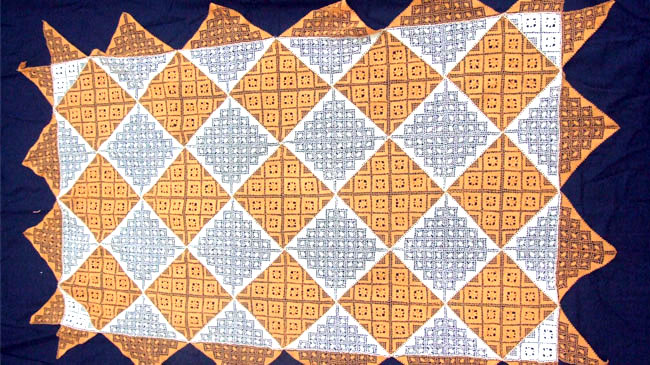
Along Galle, Weligama coastal areas, ladies are seen engaged in lace making-crochet and tatting-in the verandas of their houses. Among the products made with lace making are blouses, table linen, curtains, bed spreads and pillows.
Architecture of Sri Lanka
Architecture in Sri Lanka has always been closely associated with religion. Buddhism has always been an umbrella under which the architecture of Sri Lanka has evolved. Sri Lanka has also remained under the occupation of Portuguese, followed by the Dutch and finally the British. All these reigns left their impact on the architecture in Sri Lanka. Colonial legacy can be seen in ancient colonial buildings in the country.
Buddhist Architecture
The most prominent essence of Buddhist architecture is the Dagoba (stupa) spread everywhere in the island. The structure is in a shape of dome, often painted in white. It enshrines the Buddha's relics such as hair and tooth. Bricks are used to make the structure which is covered with plaster. The tradition of building the Stupas originated during the reign of Emperor Asoka of India who sent his son Mahinda to Sri Lanka as a Buddhist missionary. Since then Dagobas emerged in the island. The Dagobas can be seen in bubble shape, bell shape, pot shape, the heap of paddy shape, and Amalaka shape.
Hindu Architecture
Most Hindu temples in Sri Lanka are dedicated to Lord Shiva. They are known as Kovils in Sri Lanka. A Hindu temple usually consists of a prayer hall and shrine room. Shikhara is the central edifice of the Hindu temple. Shikhara is in dome or pyramid shape and richly adorned with sculptures. The visitors to the temple circumbulate the deity clockwise.
European Architecture
European architecture left considerably influenced the building construction in Sri Lanka. The Portuguese left the tiled-roof building with its veranda. Galle fort is an excellent example of Dutch legacy. British constructed elegant buildings in hill stations and Colombo.
Sculpture and Painting
Arts like sculpture and painting in Sri Lanka have always developed under the influence of Buddhism. Most works of sculpture in the country have been of Buddha images. The idols of Buddha's were carved from the living rock of limestone cliffs. Other materials like jade, rock, crystal, marble, emerald, ivory, coral and wood were also used for expressing art. Three main poses of Buddha idols are standing, meditating, and reclining. Sculptors of Sri Lanka were exquisitely skilled. They built idols which symbolised religious beliefs of the Lankans.








